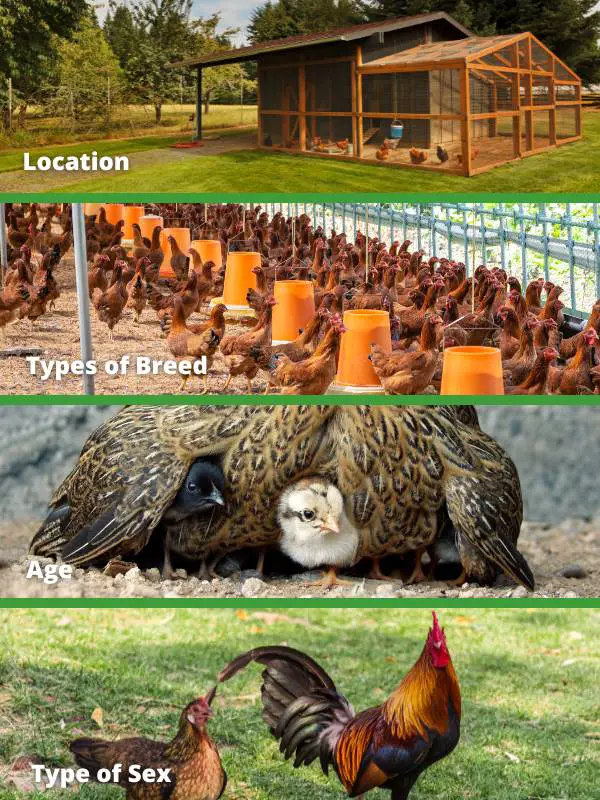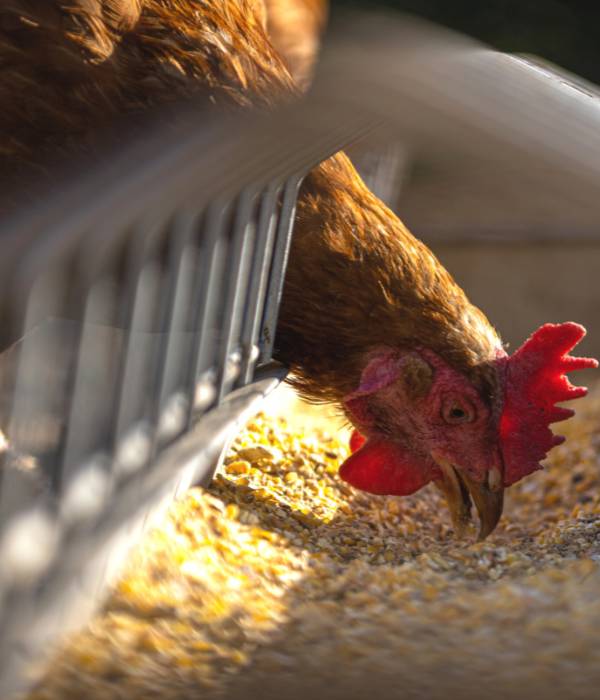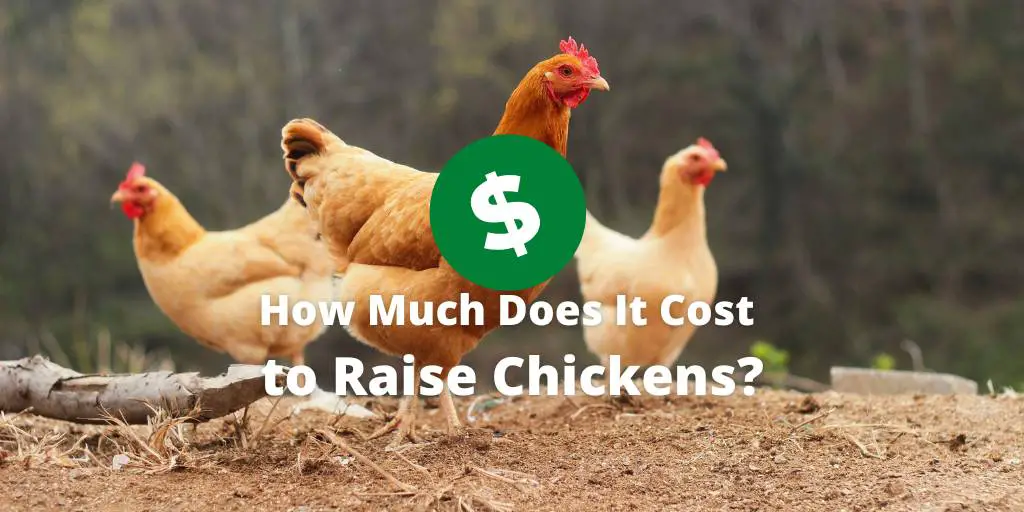How Much Does It Cost to Raise Chickens? Well, it’s a common question for all who wants to start raise chickens?
Are you thinking of adding some chickens to your backyard area? Or are you considering starting a small chicken farm? Stay here to know all about the costing.
Whatever your plans, if they include raising chickens, you’ll need to factor in the cost of various things like coop, chicks, adult birds, equipments and more.
Here’s a look at how much it costs to raise chickens?
How Much Do Chickens Cost?
Chickens have become increasingly popular as pets and livestock, but what’s the cost of owning one? It all depends on a few factors.
You need to consider the initial cost of buying or adopting your chickens, the ongoing costs for feed and housing, and any health care requirements that might come up.
Generally, expect to pay anywhere from $5-15 dollars per bird and around $150 in feed every year.
Housing chickens can also be expensive; a coop or hutch can run hundreds of dollars if you don’t build it yourself. Overall, the price of raising chickens doesn’t have to be astronomical.
With sensible buys and good planning, keeping chickens at home can be an enjoyable experience without bankrupting its owner.

1. The cost of fertilized eggs: If you want to hatch eggs at home.
If you want to get your hands dirty, raising chickens from fertilized eggs is an exciting and cost-effective way to bring life into your home.
Fertilized eggs cost a fraction of the price compared to buying already hatched chicks and can be found from local farms or online hatcheries at various prices.
While it varies based on the breed you’re looking for, average fertilized eggs will cost anywhere between $2–$5, but delivery is not included.
Once they arrive, you only need a good incubator to keep them warm until they hatch into tiny little bundles of joy and future egg layers.
2. The cost of baby chicks: If you want to go with the brooding process.
Starting a backyard chicken farming can be an exciting adventure, but many need to learn how to start. One of the first steps to consider is the cost of baby chicks.
When raising chickens from day one, brooding is often the way to go. Before buying your chicks, factor in expenses such as housing, bedding materials, and food that must be purchased for their growth period.
Feed typically costs about $20 per $40 per pound bag, depending on where you source it from, and bedding can add up too.
On average, it costs just under $3 per chick if they are bought in bulk. However, small batches of chickens may cost much more per chick.
Whatever route you decide upon, always remember to budget for these important expenses.
3. The cost of adult chickens: If you directly wish to go with the breeding process.
When trying to raise chickens, many would prefer to go right into the breeding process versus raising chicks.
If this is the route you decide to take, it is significant to know that the cost of adult chickens does vary.
Prices may depend on the breed and availability, but generally range from $5–$20 per chicken. In addition, if you get a rare breed of chicken, you can expect it to come with a heftier price tag.
Furthermore, when purchasing adult chickens, be prepared to pay additional costs of taking proper care, such as housing, food, and medical attention when necessary.
All in all, considering all of these factors make raising adult chickens similar in cost to raising your chicks in the long run.
Factors affecting cost of fertilized eggs, baby chicks, and adult chickens
Factors that affect the cost of fertilized eggs, baby chicks, and adult chickens:
Several factors can have a significant impact on the cost of fertilized eggs, baby chicks, and adult chickens.
The breed of the chicken is one of these factors, as some breeds are pricier than others due to their high-cost feed and specialized housing.
The location also matters; for instance, raising chickens in areas with colder climates may necessitate higher energy costs to maintain an appropriate temperature in their coop or shelter.
Additionally, the cost of buying baby chicks versus purchasing fertilized eggs or mature chickens plays a role in the overall price tag.
As, buying fertilized eggs will have greater up-front costs than buying a dozen baby chicks that may not all survive.
All these variables come together to create the total cost of rearing chickens. However, with proper research and planning, it’s possible to keep the expenses down.

1. Location
When considering where to raise chickens, location often plays a major part in the cost. Yes, location is a major factor that can affect the cost of fertilized eggs, baby chicks, and adult chickens.
The cost of chickens can vary significantly based on where they are being sold, with prices often being higher in urban areas due to higher demand and higher operating costs for breeders and hatcheries.
The cost of transportation can also add to the overall cost, especially if the chickens are being shipped from a different state or country.
2. Type of the breed
The type of breed you choose to raise also affects the cost. Certain breeds are pricier than others and may come with additional costs such as specialized bedding, feed, or housing requirements.
These extra expenses should be taken into consideration when selecting your breed of chicken. Rare breeds can also have a much higher price tag due to their rarity.
3. Age
The age of the chickens also plays an important role in terms of cost. Buying fertilized eggs, baby chicks, and adult chickens all have different costs associated with them.
For example, buying a dozen baby chicks might be cheaper than purchasing a box of fertilized eggs.
However, more chicks may not survive due to illness or other issues, so that cost can add up very quickly.
Adult chickens tend to be the most expensive option, but they are also more likely to survive and start laying eggs sooner than chicks.
All these factors should be taken into consideration when deciding which type of chicken you want to raise.
4. Sex of the chicken
The gender of the chicken can also affect the price. If you’re looking for egg-laying chickens, female chickens will be more expensive than males because they are the ones that lay the eggs. If you’re looking for a pet or showpiece, then males might be a better option.
How Much Will The Chicken Coop Cost?
When it comes to the chicken coop, the cost can vary significantly depending on the size and type of coop.
Generally, larger chicken coops tend to be more expensive than smaller ones in terms of materials and labor.
The type of coop you also choose matters, as some are designed with more advanced features, such as automatic coop doors or insulation, that can add additional costs.
Finally, the type of material used to build the coop will also impact the cost. Wood is typically more expensive than metal, but it can also provide more protection from the elements.
Typically, a chicken coop will cost anything between $300–$2,000, depending on the size and type of coop.

1. Making or buying cost of a portable chicken coop or tractor
The cost of a portable chicken coop or tractor can range from a few hundred to several thousand dollars, depending on the size and features.
If you build it yourself, the cost of materials will depend on the type of wood, hardware, and other supplies used. On average, the cost of materials for a basic coop can be between $200 to $800.
If you buy a ready-made portable chicken coop or tractor, the cost can range from $500 to $2000 or more, depending on the size and features.
It’s important to consider the cost of the coop in relation to the number of chickens you plan to keep and your budget.
2. Cost of building a large size chicken coop in the backyard
The cost of building a large chicken coop in the backyard can range from $1000 to $5000 or more, depending on the size and material used.
The cost of the material used in building a large chicken coop can range from $500 to $2000 or more, depending on the type of material used.
Additionally, the cost of labor involved in building a large chicken coop can range from $500 to $3000 or more.
It’s significant to factor in all the costs associated with building a large chicken coop before deciding on such a project.
3. Cost of keeping chickens in small pens/cages
The cost of keeping chickens in small pens or cages can range from as little as $50 to several hundred dollars. However, we do not recommend using a pen and cage for chickens.
The cost of the cage itself can range from $30 to $200, depending on the size and material used. Additionally, you will need to factor in the cost of feed, bedding, and other supplies.
Generally speaking, the cost of keeping chickens in small pens or cages is relatively low compared to the cost of building a larger chicken coop.
Also read: Top 15 Best Pre-made Chicken Coops
How Much Does it Cost to Feed Chickens?
The cost of feeding chickens can vary depending on the type of feed and the number of chickens you have. Here are some of the factors that determine the cost:
Type of Feed: The cost of chicken feed will vary depending on the type of feed you choose, such as starter feed, grower feed, or layer feed.
Quantity: The amount of feed you need will depend on the number of chickens you have and their age and production level.
Price of Feed: The cost of feed can vary depending on your location and the brand you choose. On average, a 50-pound bag of feed can cost between $15 to $30.
Overall, the cost of feeding chickens can range from a few dollars per month for a small flock to several hundred dollars per year for a larger flock. It is important to factor in the cost of feed when considering the cost of keeping chickens.

1. Cost of chicken feed if you are making at home
The cost of making your own chicken feed can range from a few dollars to several hundred dollars per month, depending on the ingredients you use.
Generally, the cost of making your own chicken feed is lower than the cost of purchasing commercial feed. Additionally, the homemade chicken feed can provide a more nutritious and balanced diet for your chickens.
The cost of ingredients for homemade chicken feed can range from $20 to $50 per month, depending on the types of grain and other ingredients you use.
2. Cost of Starter and Finisher feeds in the market
The cost of purchasing starter and finisher feeds in the market can range from $15 to $30 per 50-pound bag, depending on the brand and type of feed.
Additionally, you may need to factor in the cost of shipping if you purchase online. On average, a 50-pound bag of starter feed can cost between $15 to $30, while a 50-pound bag of finisher feed can cost between $20 to $40.
These are only rough estimates, and the actual cost will depend on the specific brand and location. It’s always a good idea to compare prices from different suppliers to find the best deal.
3. Cost of oyster shells and grits
The cost of purchasing oyster shells in the market can range from $5 to $25 for a 50-pound bag, depending on the size and type of product you purchase.
A 50-pound bag of grit can cost between $10 to $20, while a 50-pound bag of oyster shells can cost between $5 to $25.
Again, these are only rough estimates, and the actual cost will depend on the specific brand and location.
4. Cost of protein supplements treats like mealworms
The cost of purchasing protein supplements like mealworms can range from $10 to $25 per pound, depending on the brand and type of product you purchase.
Additionally, you may need to factor in the cost of shipping if you purchase online. On average, a pound of mealworms can cost between $10 to $25, while a pound of other protein supplements can cost between $15 to $30.
5. Other Costs
1. Cost of other chicken supplies like feeder, waterer, roosting bars, and nesting box
The cost of chicken supplies, including feeder, waterer, roosting bars, and nesting box, can range from a few dollars for basic plastic supplies to several hundred dollars for more elaborate wooden structures.
Additionally, you may need to factor in the cost of shipping if you purchase online. On average, a plastic feeder and waterer can cost between $5 to $15 each, while a wooden roosting bar and nesting box can cost between $20 to $50 each.
Not only this, some chicken raisers also provide chicken toys to their flocks. That costs from $10-20 each.
Here are some rough estimates for common chicken supplies:
Feeder: $10 to $30
Waterer: $10 to $30
Roosting bar: $10 to $30
Nesting box: $30 to $60
2. Cost of immunization and medicines
The cost of immunizations and medications for chickens can vary depending on the types of vaccines and products you use.
Generally, an initial set of vaccines will cost between $15 to $30, while additional booster shots and medications can cost between $5 and $25 per item.
Cost projections calculation to raise chickens
(Calculate and provide a final estimation of the amount needed to raise ten chickens / year in the United States)
Here is an estimated cost projection for raising ten chickens per year in the United States:
Chicken coop: $300 to $1,500
Chickens: $3 to $10 per bird
Feed: $150 to $300 per year
Bedding: $100 to $150 per year
Supplies: $100 to $200 per year
Medical supplies: $50 to $100 per year
Miscellaneous: $100 to $200 per year
—————————————————–
Total estimated cost for raising chickens: $800 to $3,000 per year.
It’s important to note that these estimates are rough, and the actual cost of raising chickens will depend on several factors, such as the type of coop, the quality of feed, and the frequency of supplies and equipment replacements.
It’s always a good idea to research and compare prices from different suppliers to get a more accurate estimate of the cost of raising chickens in your specific area.
Is it worth raising chickens?
The decision to raise chickens is ultimately up to you. While the cost of raising chickens can be substantial, there are many benefits that come with it.
Not only do chickens provide a steady supply of fresh eggs, but they also act as natural pest controllers and can even help fertilize gardens.
Furthermore, raising chickens can be a great way to teach children about animal husbandry and responsibility. Ultimately, the decision of whether to raise chickens comes down to personal preference and budget.
I hope this guide helped you to calculate your cost


